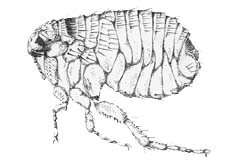Life Cycle
The life stages of
the cat flea (Ctenocephalides felis) have
many steps, and it all starts with the laying of eggs. A Female flea
can drop twenty to thirty eggs a day over her life span. (Milne 1980) The lifespan,
in optimal conditions will, on
average, last for two to three years. This allows
the female to lay about 2,000 eggs during her lifespan while being
capable to lay 25-40 eggs per day. (Purdue
University 2008) Most eggs are deposited in animal beddings,
along baseboards, in carpets, on furniture, or even on the animal
itself. (Oklahoma State University)
To find hosts and areas to lay eggs, adult cat fleas use
thermal and visual cues. They are sensitive to wavelengths between 510 and
550 nm and are completely insensitive to wavelengths between 650 and 700
nm. After the eggs are laid, about 70% of them are dislodged within 8
hours, but among those that still remain, if the temperature is between
16-27°C
and the humidity
greater than 50%, over 70% will likely hatch. (Rust
and Dryden 1997) After the eggs hatch they enter a
larval stage where hooks are developed on the ventral side (underside)
of the larvae allowing the larvae to attach to the cat's skin, hair, or
bedding making it more difficult for the larvae to be swept away. (Milne
1980) However, if the larvae/developing flea do not develop on
a host, they will acquire their nutrition through feeding on any organic
matter it can find, in particular excreted
adult feces that fall to the ground or through cannibalism of
non-fertile eggs. (Rust 2005) The
larva soon begins to pupate (stage of metamorphosis) into an adult flea
where it will remain for the rest of its life feeding off its host's
blood. (Milne 1980)
The three larval stages last approximately 7-14 days
under suitable conditions of temperature, humidity, and food
availability. Then the cat flea pupa can usually develop into an adult
within 1-2 weeks. Thus, the entire life cycle can usually be completed
within 21-28 days. Then, once it reaches the adult stage, it is able to
survive for weeks indoors without feeding, but during this time females
will not produce eggs. (Purdue University 2008)

